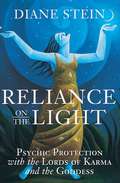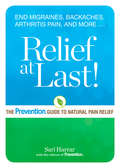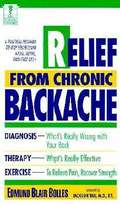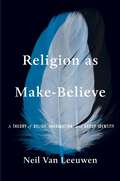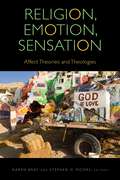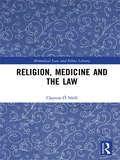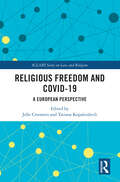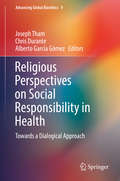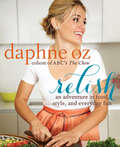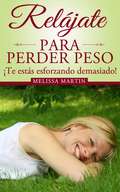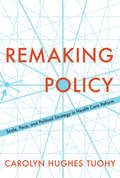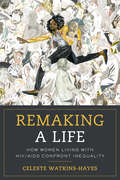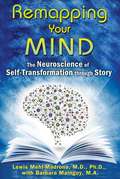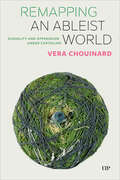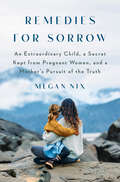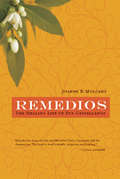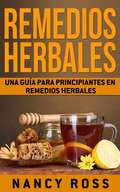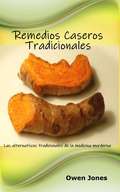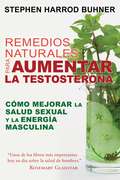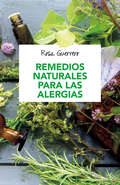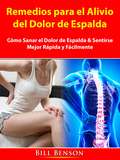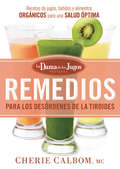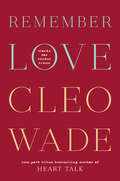- Table View
- List View
Reliance on the Light: Psychic Protection with the Lords of Karma and the Goddess
by Diane SteinWritten for intermediate to advanced healers, RELIANCE ON THE LIGHT explains how to identify negative interference and create psychic protection in daily life through meditation and visualization. Diane Stein is concerned that a darkness has engulfed the world in the form of violence against humanity, ecological destruction, and prevailing hopelessness, and so she designed her teachings to help people gain access to the Light-the radiant energy of goodness and understanding. Achieving the psychic protection of this energy creates a collective healing process that promotes positive energy and hope.From the Trade Paperback edition.
Relief at Last!: The Prevention® Guide to Natural Pain Relief
by Sarí HarrarChronic pain is something that no one should have to suffer from, yet 50 million Americans do. But new research can help put an end to that. Relief at Last! by Sari Harrar is a comprehensive guide that exposes the root causes of more than 60 common conditions—from tendinitis to heartburn to fibromyalgia—and helps readers find immediate relief from pain, in addition to everyday strategies to permanently alleviate ailments of the joints, muscles, and other achy body parts.So that readers don't need to wade through the staggering amount of contradictory information about what's safe and what's effective, Relief at Last presents the latest doctor-reviewed research to provide an overview of where and why pain begins, and then put that knowledge to use in determining the best way to say goodbye to it forever—using proven combinations of conventional and complementary therapies.Pain is different for every individual. With the knowledge provided in Relief at Last and an easy-to-use pain diary to track success, readers will equip themselves with all the tools needed to manage flare ups and find a customized solution to reduce their pain over the long term.
Relief from Chronic Backache
by Edmund Blair BollesHere is the tested, proven regimen that will ease the pain that holds you hostage and restore your back to full physical function. Here is the book that debunks the myths about backache. Complete with self-exams that test your attitude toward pain, an extensive glossary, and much more to help you ease your back pain and put you in charge of your life -- for good!
Religion as Make-Believe: A Theory of Belief, Imagination, and Group Identity
by Neil Van LeeuwenTo understand the nature of religious belief, we must look at how our minds process the world of imagination and make-believe.We often assume that religious beliefs are no different in kind from ordinary factual beliefs—that believing in the existence of God or of supernatural entities that hear our prayers is akin to believing that May comes before June. Neil Van Leeuwen shows that, in fact, these two forms of belief are strikingly different. Our brains do not process religious beliefs like they do beliefs concerning mundane reality; instead, empirical findings show that religious beliefs function like the imaginings that guide make-believe play.Van Leeuwen argues that religious belief—which he terms religious “credence”—is best understood as a form of imagination that people use to define the identity of their group and express the values they hold sacred. When a person pretends, they navigate the world by consulting two maps: the first represents mundane reality, and the second superimposes the features of the imagined world atop the first. Drawing on psychological, linguistic, and anthropological evidence, Van Leeuwen posits that religious communities operate in much the same way, consulting a factual-belief map that represents ordinary objects and events and a religious-credence map that accords these objects and events imagined sacred and supernatural significance.It is hardly controversial to suggest that religion has a social function, but Religion as Make-Believe breaks new ground by theorizing the underlying cognitive mechanisms. Once we recognize that our minds process factual and religious beliefs in fundamentally different ways, we can gain deeper understanding of the complex individual and group psychology of religious faith.
Religion, Emotion, Sensation: Affect Theories and Theologies (Transdisciplinary Theological Colloquia)
by Karen Bray and Stephen D. MooreReligion, Emotion, Sensation asks what affect theory has to say about God or gods, religion or religions, scriptures, theologies, and liturgies. Contributors explore the crossings and crisscrossings between affect theory and theology and the study of religion more broadly, as well as the political and social import of such work.Bringing together affect theorists, theologians, biblical scholars, and scholars of religion, this volume enacts creative transdisciplinary interventions in the study of affect and religion through exploring such topics as biblical literature, Christology, animism, Rastafarianism, the women’s Mosque Movement, the unending Korean War, the Sewol ferry disaster, trans and gender queer identities, YA fiction, queer historiography, the prison industrial complex, debt and neoliberalism, and death and poetry.Contributors: Mathew Arthur, Amy Hollywood, Wonhee Anne Joh, Dong Sung Kim, A. Paige Rawson, Erin Runions, Donovan O. Schaefer, Gregory J. Seigworth, Max Thornton, Alexis G. Waller
Religion, Medicine and the Law (Biomedical Law and Ethics Library)
by Clayton Ó NéillIs the legal protection that is given to the expression of Abrahamic religious belief adequate or appropriate in the context of English medical law? This is the central question that is explored in this book, which develops a framework to support judges in the resolution of contentious cases that involve dissension between religious belief and medical law, developed from Alan Gewirth’s Principle of Generic Consistency (PGC). <P><P>This framework is applied to a number of medical law case studies: the principle of double effect, ritual male circumcision, female genital mutilation, Jehovah’s Witnesses (adults and children) who refuse blood transfusions, and conscientious objection of healthcare professionals to abortion. <P><P>The book also examines the legal and religious contexts in which these contentious cases are arbitrated. It demonstrates how human rights law and the proposed framework can provide a gauge to measure competing rights and apply legitimate limits to the expression of religious belief, where appropriate. The book concludes with a stance of principled pragmatism, which finds that some aspects of current legal protections in English medical law require amendment.
Religious Freedom and COVID-19: A European Perspective (ISSN)
by Jelle Creemers and Tatiana KopaleishviliThe impact of the COVID-19 pandemic will be a topic for academic research for years to come. This collection brings together international scholars from various disciplines to analyse the impact of the pandemic on both religious freedom and on religious community life in Europe.Divided into two parts, the first focuses on theoretical considerations, while the second explores local challenges and includes case studies from countries with different socio-political profiles. The book includes critical evaluations of public crisis management of religious communities during the pandemic, as well as critical reflections on religious freedom appeals in such crisis.In sum, the volume probes and challenges scholars and students of law, religion, politics, and sociology to go beyond the typical oppositions in considering Freedom of Religious Belief in the current secular European context. The work will be a valuable resource for academics, researchers, and policy-makers working in the areas of Law and Religion, Human Rights Law, Sociology, and Political Science.
Religious Perspectives on Social Responsibility in Health: Towards A Dialogical Approach (Advancing Global Bioethics Ser. #9)
by Joseph Tham Chris Durante Alberto García GómezThis book discuss the meaning and implications of the social and ethical implications of the notion of social responsibility in healthcare in six major world religions — Buddhism, Christianity, Confucianism, Hinduism, Islam, & Judaism. This collection of papers is based on a four-day workshop where bioethics experts from various religious traditions gathered. They discussed the ways in which their respective traditions could, or could not, uphold the tenets of Article 14 of UNESCO's Universal Declaration of bioethics and Human Rights. The different papers presented in this book are based on this interchange of ideas at the workshop. The book explores the potential points of convergence among the various perspectives presented, as well as a discussion on the ways in which their moral differences may be managed. The managing of these moral differences through international socio-ethical mechanisms, contributes significantly to the UNESCO Universal Declaration of Bioethics and Human Rights’ goal of simultaneously respecting religio-cultural pluralism while upholding a commitment to human rights.
Relish
by Daphne OzOz--a co-host on the hit daytime talk show "The Chew," bestselling author of "The Dorm Room Diet," and Dr. Mehmet Oz's daughter--offers simple, practical advice on living the best life right now.
Relájate Para Perder Peso
by Melissa Martin Vanesa Alvarez OrtizCómo perder libras sin dietas exigentes, trucos ni píldoras peligrosas, usando el poder de la alimentación razonable, el agua, el oxígeno y la psicología de la imagen personal Ya contaste calorías. Te atiborraste de proteínas y después de carbohidratos. Hiciste la dieta del pomelo, la del chocolate y la de la banana. Corriste horas alrededor de la manzana. Fuiste a reuniones semanales. Gastaste dinero en costosas máquinas de ejercicios. Bebiste galones de batidos. Consumiste miles de píldoras. Comiste cientos de barras de reemplazo de comidas. Mantuviste un registro diario o un blog sobre tu pérdida de peso. Compraste platos pequeños para que tus porciones parezcan grandes. Desperdiciaste miles de dólares en alimentos especiales. Te engrapaste las orejas. Sin embargo, sigues teniendo sobrepeso. Quizás perdiste algunas libras, pero las recuperaste y engordaste más. Este es el momento para dejar de esforzarte tanto para perder peso y adelgazar de una manera más fácil. Relájate para perder peso. Es la única forma de hacerlo. Sin correr cientos de millas. Sin saltar todo el día con un DVD aeróbico. Sin dietas tediosas. Sin comprar alimentos especiales. Sin contar calorías. Sin pelear contra tus antojos. Ya no te estreses por tu peso. Relájate y deja que tu cuerpo delgado sea libre.
Remaking Policy: Scale, Pace, and Political Strategy in Health Care Reform
by Carolyn TuohyOne of the most persistent puzzles in comparative public policy concerns the conditions under which discontinuous policy change occurs. In Remaking Policy, Carolyn Hughes Tuohy advances an ambitious new approach to understanding the relationship between political context and policy change. Focusing on health care policy, Tuohy argues for a more nuanced conception of the dynamics of policy change, one that makes two key distinctions regarding the opportunities for change and the magnitude of such changes. Four possible strategies emerge: large-scale and fast-paced ("big bang"), large-scale and slow-paced ("blueprint"), small-scale and rapid ("mosaic"), and small-scale and gradual ("incremental"). As Tuohy demonstrates, these strategies are determined not by political and institutional conditions themselves, but by the ways in which political actors, individually and collectively, read those conditions to assess their prospects for success in the present and over time. Drawing on interviews as well as primary and secondary accounts of ten health policy cases over seven decades (1945—2015) in the US, UK, the Netherlands, and Canada, Remaking Policy represents a major advance in understanding the scale and pace of change in health policy and beyond.
Remaking a Life: How Women Living with HIV/AIDS Confront Inequality
by Celeste Watkins-HayesIn the face of life-threatening news, how does our view of life change—and what do we do it transform it? Remaking a Life uses the HIV/AIDS epidemic as a lens to understand how women generate radical improvements in their social well being in the face of social stigma and economic disadvantage. Drawing on interviews with nationally recognized AIDS activists as well as over one hundred Chicago-based women living with HIV/AIDS, Celeste Watkins-Hayes takes readers on an uplifting journey through women’s transformative projects, a multidimensional process in which women shift their approach to their physical, social, economic, and political survival, thereby changing their viewpoint of “dying from” AIDS to “living with” it. With an eye towards improving the lives of women, Remaking a Life provides techniques to encourage private, nonprofit, and government agencies to successfully collaborate, and shares policy ideas with the hope of alleviating the injuries of inequality faced by those living with HIV/AIDS everyday.
Remapping Your Mind: The Neuroscience of Self-Transformation through Story
by Lewis Mehl-Madrona Barbara MainguyA guide to retelling your personal, family, and cultural stories to transform your life, your relationships, and the world • Applies the latest neuroscience research on memory, brain mapping, and brain plasticity to the field of narrative therapy • Details mind-mapping and narrative therapy techniques that use story to change behavior patterns in ourselves, our relationships, and our communities • Explores how narrative therapy can help replace dysfunctional cultural stories with ones that build healthier relationships with each other and the planet We are born into a world of stories that quickly shapes our behavior and development without our conscious awareness. By retelling our personal, family, and cultural narratives we can transform the patterns of our own lives as well as the patterns that shape our communities and the larger social worlds in which we interact. Applying the latest neuroscience research on memory, brain mapping, and brain plasticity to the field of narrative therapy, Lewis Mehl-Madrona and Barbara Mainguy explain how the brain is specialized in the art of story-making and story-telling. They detail mind-mapping and narrative therapy techniques that use story to change behavior patterns in ourselves, our relationships, and our communities. They explore studies that reveal how memory works through story, how the brain recalls things in narrative rather than lists, and how our stories modify our physiology and facilitate health or disease. Drawing on their decades of experience in narrative therapy, the authors examine the art of helping people to change their story, providing brain-mapping practices to discover your inner storyteller and test if the stories you are living are functional or dysfunctional, healing or destructive. They explain how to create new characters and new stories, ones that excite you, help you connect with yourself, and deepen your intimate connections with others. Detailing how shared stories and language form culture, the authors also explore how narrative therapy can help replace dysfunctional cultural stories with those that offer templates for healthier relationships with each other and the planet.
Remapping an Ableist World: Disability and Oppression under Capitalism
by Vera ChouinardRemapping an Ableist World examines the forces shaping our lives in an able capitalist world. It draws on examples including human enhancement and the organ trade to illustrate connections between able capitalist ways of life, impairment, disability, and oppression. The book addresses ableness as a regime of power and oppression intrinsic to global capitalism and, as such, a system that touches all of our lives, albeit in different ways. Vera Chouinard offers an intersectional analysis of the production of impairment and disability, drawing on autoethnographic and autobiographical methodologies, case studies of disability in the Global South and North, and comparative accounts of processes such as the uneven development of disability law. Inviting readers to rethink the causes and consequences of the ableist capitalist order in which we find ourselves, Remapping an Ableist World reminds us that for our own well-being and that of generations to comes we must forge a less destructive and more nurturing way of life.
Remedies for Sorrow: An Extraordinary Child, a Secret Kept from Pregnant Women, and a Mother's Pursuit of the Truth
by Megan NixThis "compulsively readable memoir...brings to light an issue that has been too long ignored...An immensely important book" (Emily Oster, New York Times bestselling author of Expecting Better and Cribsheet).A story of a mother&’s fierce love for her exceptional child and her courageous journey to break the silence about a hidden risk to pregnant women: "both a beautiful family story and an urgent call to action… [A] moving, potentially life-altering book" (Robert Kolker, author of #1 New York Times bestseller Hidden Valley Road).After a seemingly uneventful pregnancy, Megan Nix&’s second daughter, Anna, was born very small and profoundly deaf. Megan and her husband, Luke, learned that Anna could have lifelong delays due to an infection from a virus they had never heard of: cytomegalovirus, or CMV, which Megan had unwittingly contracted from her toddler during pregnancy.Megan was electrified by this knowledge. She had been warned, while pregnant, about the risks of saunas, sushi, and unpasteurized cheese, a lack of folic acid, and an excess of kitty litter. She knew to fear a slew of genetic syndromes she could do little to prevent. But she had not been told that CMV is contagious in the saliva of one out of three toddlers, spread through a kiss, a shared cup, a bite of unfinished toast. She had not been told that the stakes were high, that congenital CMV causes more birth defects and childhood disabilities—including blindness, deafness, cerebral palsy, epilepsy, and autism—than any infectious disease. Or that some of these disabilities are evident at birth, but others appear suddenly at age two or three and are never traced back to congenital CMV.Remedies for Sorrow unfolds across the dramatic landscape of Sitka, Alaska, where Luke makes his living as a salmon fisherman. There, Megan struggles to meet Anna&’s needs and dives deeper into the mystery of why no one—not her OBGYN, not her toddler&’s pediatrician—had mentioned CMV, despite the staggering cost of this silence to families and children like Anna. From this rugged and beautiful place comes a memoir about the boundless capacity of mothers, the extraordinary child that is Anna, and the lifesaving power of truth.
Remedios
by Joanne B. MulcahyFormer President Ronald Reagan called Eva Castellanoz a "national treasure" when he awarded her an NEA National Heritage Fellowship in 1987. Featured in National Geographic, National Public Radio, and numerous other publications, Castellanoz is celebrated as a folk artist, community activist and a curandera, a traditional Mexican healer who uses a mind-body-spirit approach. During her 16 year friendship with Joanne Mulcahy, Castellanoz has revealed her life story as well as her remedios - her remedies, both medicinal and metaphoric - for life's maladies. Using her own observations and Castellanoz's stories, Mulcahy employs creative nonfiction and oral accounts to portray the life, beliefs, and practices of this remarkable woman. Anyone who has been healed by Eva Castellanoz has felt her power and wisdom. Anyone who reads this vivid portrait will come away feeling wiser and empowered by the story of this courageous and loving healer.
Remedios
by Joanne B. MulcahyFormer President Ronald Reagan called Eva Castellanoz a "national treasure" when he awarded her an NEA National Heritage Fellowship in 1987. Featured in National Geographic, National Public Radio, and numerous other publications, Castellanoz is celebrated as a folk artist, community activist and a curandera, a traditional Mexican healer who uses a mind-body-spirit approach. During her 16 year friendship with Joanne Mulcahy, Castellanoz has revealed her life story as well as her remedios - her remedies, both medicinal and metaphoric - for life's maladies. Using her own observations and Castellanoz's stories, Mulcahy employs creative nonfiction and oral accounts to portray the life, beliefs, and practices of this remarkable woman. Anyone who has been healed by Eva Castellanoz has felt her power and wisdom. Anyone who reads this vivid portrait will come away feeling wiser and empowered by the story of this courageous and loving healer.
Remedios Herbales: Una Guía para Principiantes en Remedios Herbales
by Nancy Ross Ana María Skarmeta BustosLos remedios herbales existen hace miles de años. Muchas culturas los han usado como parte del proceso curativo durante años, con la esperanza de mejorar la calidad de vida de los pacientes. Aunque nuestro mundo moderno tiene muchos otros medicamentos que puedes elegir cada día para aliviar el dolor, el resfrío o la gripe, entre muchos, la mayoría de ellos cuestan mucho dinero y sus efectos colaterales no son saludables para el organismo. En los últimos años, cada vez más personas están buscando nuevas respuestas para sus preocupaciones más frecuentes sobre salud. Esto puede ser debido a que están cansadas de tomar un medicamento que no es saludable o uno que no está cumpliendo todas sus promesas. Otras simplemente no pueden pagar el alto costo de la medicación y sienten que necesitan encontrar otra solución. Afortunadamente, los remedios herbales son con frecuencia una de las mejores elecciones para tu salud, ya que son seguros, efectivos, e incluso puedes cultivarlos en tu jardín. En esta guía podrás aprender todo lo que necesitas saber para empezar a usar los remedios herbales para mantener o mejorar tu salud y bienestar.
Remedios caseros tradicionales: De alternativas antiguas a metodos modernos (Como hacer... #3)
by Owen JonesHola y gracias por comprar este libro electrónico llamado “Remedios Caseros tradicionales” Espero que encuentre esta información, útil y rentable. La información de este libro electrónico sobre varios aspectos de los remedios caseros tradicionales e ideas relacionadas, esta organizada en 19 capítulos de aproximadamente 500 a 600 palabras cada uno. Espero que sea de interés, a quienes piensan que últimamente estamos tomando demasiados productos químicos. Como beneficio adicional, le otorgo permiso para usar el contenido en su propio sitio web o en sus propios blogs y boletines, aunque mejor si los reescribe primero con sus propias palabras. También puede dividir el libro y revender los artículos. De hecho el único derecho que no tiene es revender o regular el libro tal y como está.
Remedios naturales para aumentar la testosterona: Cómo mejorar la salud sexual y la energía masculina
by Stephen Harrod BuhnerCómo mantener los niveles óptimos de testosterona en el hombre mediante el uso de hierbas, suplementos nutricionales y la alimentación• Revela pruebas científicas sobre agentes ambientales que bloquean la testosterona y que alteran el funcionamiento químico del cuerpo masculino en la medida en que este envejece • Presenta medicinas herbarias orgánicas y seguras que pueden restablecer los niveles óptimos de testosterona• Contiene los tratamientos naturales más recientes para tratar la impotencia, la infertilidad y las disfunciones de próstataLa identificación de la andropausia, la etapa que ocurre durante la madurez en los hombres y que es comparable a la menopausia femenina, se ve obstaculizada por la falta de una clara manifestación externa en la química y fisiología propias de los individuos de edad avanzada. Los hombres son capaces de fecundar más allá de la edad madura. Sin embargo, su deseo y potencia sexual varían, a menudo de acuerdo con su nivel de testosterona. Estudios recientes muestran que los bajos niveles de testosterona prevalentes en varones de edad avanzada--un descenso gradual que es bastante normal--se ven agravados por elementos del medio ambiente. Pero, como indican investigaciones médicas recientes, la terapia de reemplazo de testosterona con dosis bajas de la hormona no es una opción adecuada porque aumenta el riesgo de problemas cardiovasculares como el infarto del miocardio o derrames cerebrales y, además, porque el cuerpo puede hacerse dependiente de la testosterona farmacéutica y dejar de producirla por sí mismo.En esto libro, Stephen Harrod Buhner muestra por qué los hombres necesitan ayuda para mantener los niveles de testosterona a medida en que envejecen y explica cómo fitoandrógenos naturales--plantas medicinales que contienen hormonas masculinas--pueden corregir sin riesgos la disminución de testosterona que ejerce el medio ambiente. Buhner detalla cómo funciona cada fitoandrógeno, cuándo puede usarse y el método más apropiado de empleo, de forma que proporcione a todos los hombres medios seguros, naturales y eficaces que conserven sus niveles óptimos de testosterona hasta bien entrada la tercera edad.
Remedios naturales para las alergias
by Rosa Guerrero¿Por qué unos simples granos de polen, unos inofensivos ácaros o unos pelos de nuestra mascota pueden provocarnos reacciones alérgicas? Las alergias son la expresión de un desequilibrio interior que responde a múltiples causas. No solo hay que averiguar qué alérgenos originan la reacción, también hay que comprender las razones del desequilibrio de nuestro sistema inmunológico y saber que existe todo un abanico de posibles soluciones para paliar alergias. Cada persona es diferente y cada organismo tiene diferentes necesidades. Por eso, los remedios no pueden ser genéricos. En este libro encontrarás: Explicaciones detalladas sobre las principales alergias y sus características.Información completa sobre las terapias naturales que existen para remediar las reacciones alérgicas del organismo.Claves para entender el comportamiento de nuestro sistema inmunológico.Consejos sobre la dieta adecuada que debe seguir una persona alérgica.Análisis de casos particulares que ejemplifican los detalles que intervienen en una alergia.
Remedios naturales para las alergias
by Rosa Guerrero¿Por qué unos simples granos de polen, unos inofensivos ácaros o unos pelos de nuestra mascota pueden provocarnos reacciones alérgicas? Las alergias son la expresión de un desequilibrio interior que responde a múltiples causas. No solo hay que averiguar qué alérgenos originan la reacción, también hay que comprender las razones del desequilibrio de nuestro sistema inmunológico y saber que existe todo un abanico de posibles soluciones para paliar alergias. Cada persona es diferente y cada organismo tiene diferentes necesidades. Por eso, los remedios no pueden ser genéricos. En este libro encontrarás: Explicaciones detalladas sobre las principales alergias y sus características. Información completa sobre las terapias naturales que existen para remediar las reacciones alérgicas del organismo. Claves para entender el comportamiento de nuestro sistema inmunológico. Consejos sobre la dieta adecuada que debe seguir una persona alérgica. Análisis de casos particulares que ejemplifican los detalles que intervienen en una alergia.
Remedios para el Alivio del Dolor de Espalda: Cómo Sanar el Dolor de Espalda & Sentirse Mejor Rápida y Fácilmente
by Hiddenstuff Entertainment¿Le gustaría ser capaz de ayudar a eliminar el dolor de espalda y la incomodidad? ¡Desde hace mucho tiempo, técnicas naturales de sanación se han usado para atender una cantidad de malestares! Usando estas técnicas para aliviar el dolor de espalda también le ayudará con enfermedades crónicas, inflamación, su sistema inmune, niveles de energía, enfoque, felicidad en general, ¡y mucho más! ¡Presentando los secretos que los profesionales de sanación usan para sentirse tan saludable como nunca antes! Con décadas de estrategias comprobadas, este libro en formato ebook le mostrará la forma más rápida y efectiva para atender su dolor de espalda ¡y beneficiar su bienestar! Aprenderá cómo incrementar su bienestar en tan solo pocas semanas. No solo eso, sino que también mejorará literalmente cada aspecto de su vida. ¿Quiere conocer cómo las personas atienden las enfermedades crónicas y malestares? Usted también puede aprender los secretos para alcanzar esto y permitiendo que usted sea más feliz y saludable. Esta guía le enseña técnicas comprobadas sin el uso de suplementos caros o cursos. Qué está incluido: - Remedios. - Vencer una Enfermedad Crónica. - Tener Más Energía. - Dormir Mejor. - Superar Malestares. - Nutrición. - Lo Que Usted Debe Saber. + ¡MUCHO MÁS! Si usted quiere estar más saludable, curar malestares o mejorar su enfoque y bienestar entonces esta guía es para usted. --> Avance al principio de la página y haga clic en Agregar Al Carrito para comprarlo instantáneamente Descargo de responsabilidad: Este autor o propietario(s) de los derechos no hace afirmaciones, promesas o garantías en lo concerniente a la exactitud, plenitud o adecuación de los contenidos de este libro, y expresamente renuncia a la responsabilidad por errores y omisiones en su contenido. Este producto es para usarse solo como referencia. Por favo
Remedios para los desórdenes de la tiroides de la Dama de los Jugos: Recetas de jugos, batidos y alimentos orgánicos
by Cherie CalbomLa tiroides es una de las glándulas más importantes del cuerpo, que ayuda a regular casi todos los demás sistemas. El tercer libro de la serie La dama de los jugos, Remedios para los desórdenes de la tiroide se centrará en la glándula tiroides, que está vinculada con el metabolismo y el apetito; cambios de humor; la aparición de cabello, piel, y uñas; músculos, problemas de las articulaciones, y más. Este libro incluirá: - Tés curativos, zumos, y batidos - Smoothies verdes que aportan un gran alcance de fitonutrientes y antioxidantes - Recomendaciones de comida cruda - Una sección deconsejos sobre cómo elegir el mejor exprimidor y los mejores productos de electrónica, así como consejos para preparar, limpiar y almacenar sus zumos y batidos, y mucho más!
Remember Love: Words for Tender Times
by Cleo WadeFrom the beloved, New York Times bestselling author of Heart Talk, a collection of prose and poetry that explores how we can find light in periods of lostness, love for ourselves after heartbreak, okay-ness in the midst of change, and strength in letting go. How do we find steadiness within ourselves in the midst of dizzying personal and global change? At a time when many of us feel overwhelmed by fear and isolation, Cleo Wade&’s Remember Love offers intimate, uplifting words that anchor, nurture, and make us feel less alone. She shares that the heart work we do for ourselves is not done to avoid the tough stuff—periods of lostness, self-doubt, depression, grief, heartbreak, and anxiety. Wade instead suggests that to live is to get lost, and it&’s our task, our great privilege, to learn to love ourselves so that we can handle these periods and our discomfort does not block our healing. Remember Love reminds us that lostness is not our permanent state but a starting point for self-discovery, connection, and growth.
